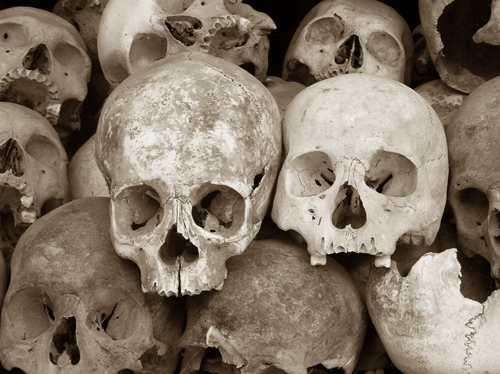The Killing Fields

On April 17, 1975, an organization known as the Khmer Rouge forcibly took power in Cambodia. On that day the Khmer Rouge evacuated the cities of Cambodia, forcing men, women, children, the sick, the disabled, and the elderly to march for days into the countryside with only the possessions they could carry. Those who refused, or were unable to comply, were killed.
The Khmer Rouge, and their maniacal leader, Pol Pot, claimed to believe in an agrarian utopia where all citizens were farmers, and where everyone was equal. They touted a crimeless society without aggression, corruption, or greed. Yet, the methods they used to create such a “utopia” rank among the most brutal and insidious in human history.
The citizens of Cambodia were forced into slave labor in the fields. People were forced to work 12-15 hours a day growing food for the regime to sell to communist China in exchange for weapons, yet were given at most two meager meals of watery rice gruel a day. Families were shattered, as the fathers were often bludgeoned to death, kids were sent to labor camps spread across the countryside, and mothers and babies were left to die of starvation or disease in the villages.
Many educated Cambodians were considered enemies of the regime, and suffered greatly as a result. The most notorious of Pol Pot’s torture chambers was the prison known as Tuol Sleng Security Prison 21. Formerly a high school in Phnom Penh, Tuol Sleng was turned into a macabre torture chamber designed to extract “confessions” from the victims before they were murdered in the nearby killing field of Choeung Ek. At the height of the insanity, Tuol Sleng claimed 100 victims a day.
Killing fields dot the Cambodian countryside. At Choeung Ek, 76 mass graves containing 8,985 victims have been exhumed; 43 additional mass graves remain untouched. Fragments of bones and teeth litter the field, as do remnants of clothing worn by victims on the day of their execution. Although most of the victims were bludgeoned to death to save precious ammunition, bullets can be found along the paths between the graves. Nearby trees still bear the scars where the skulls of children were crushed against the trunk.
The Khmer Rouge came to power in an Asia torn apart by Communism and war. The Americans were struggling in Vietnam against the Chinese- and Russian-supported spread of Communism, and North Vietnam wanted to use the Cambodian countryside to advance southward towards Saigon. The fledging Khmer Rouge agreed to help the Vietnamese Communists in exchange for training and support. When America illegally carpet-bombed the eastern half of Cambodia and killed upwards of 250,000 Cambodian citizens, the Khmer Rouge gained legions of angry followers eager to fight the American-backed Cambodian government.
Ironically, it was the Vietnamese that ended Pol Pot’s terror in Cambodia. After Pol Pot ordered numerous incursions into Vietnam, the Communist Vietnamese government roared back on Christmas Day, 1978, taking control of Cambodia in a mere two weeks. Although the Khmer Rouge would continue to fight against the Vietnamese-installed government until 1998, the reign of terror had effectively come to an end three years, eight months, twenty-one days after it had begun.
It is still not known how many Cambodians died at the hands of the Khmer Rouge. Most estimate the death toll to be somewhere between two and three million – over ¼ of the population of Cambodia.
Although the United Nations halfheartedly formed a war crimes tribunal to prosecute the Khmer Rouge leaders for the atrocities they committed against their own people, the UN inexplicably pulled out of the process in 2002. While Pol Pot died in 1998, many former leaders of the Khmer Rouge remain free. Despite heavy pressure from some in the international community, the Cambodian’s people’s search for justice continues.
The Photographs of Tuol Sleng and Choeung Ek are graphic, troubling, and profoundly depressing. The images represented here are just examples of those that can be taken all over Cambodia, as no part of the country was spared the madness. It is deplorable that acts such as these can, and still do, take place in the modern world.

Post a Comment
<< Home